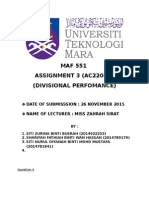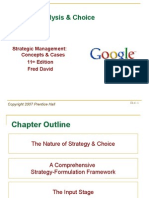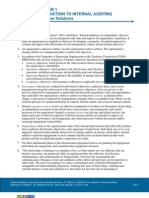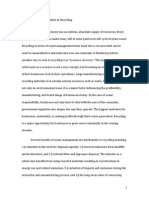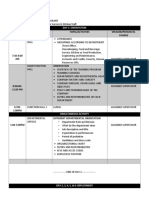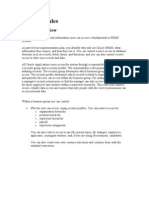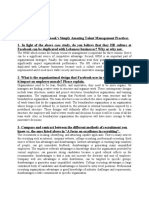Outline Strategic Audit
Outline Strategic Audit
Uploaded by
amjad987Copyright:
Available Formats
Outline Strategic Audit
Outline Strategic Audit
Uploaded by
amjad987Copyright
Available Formats
Share this document
Did you find this document useful?
Is this content inappropriate?
Copyright:
Available Formats
Outline Strategic Audit
Outline Strategic Audit
Uploaded by
amjad987Copyright:
Available Formats
I.
Current Situation a. Current Performance i. How did the corporation perform the past year overall in terms of ROI, market share, and profitability? b. Strategic Posture What are the corporations current mission, objectives, strategies and policies? i. Are they clearly stated, or are they merely implied from performance? ii. Mission: What business is the corporation in? Why? iii. Objectives: What are the corporate, business, and functional objectives? Are they consistent with each other, with the mission, and with the internal and external environment? iv. Strategies: What strategy or mix of strategies is the corporation following? Are they consistent with each other, with the mission and objectives, and with the internal and external environments? v. Policies: What are the corporations policies? Are they consistent with each other, with the mission, objectives, and strategies, and with the internal and external environment? vi. Do the current mission, objectives, strategies, and policies reflect the corporations international operations, whether global or multi-domestic?
II. Corporate Governance a. Board of Directors i. Who is on the board? Are they internal or external members? ii. Do they own significant of stock? iii. Is the stock privately held or publicly traded? Are there different classes of stock with different voting rights? iv. What do the board members contribute to the corporation in terms of knowledge, skills background, and connections? If the
corporation has international operations, do board members have international experience? v. How long have members served on the board? vi. What is their level of involvement in strategic management? Do they merely rubberstamp top managements proposal, or do they actively participate and suggest future directions? b. Top Management i. What person or group constitutes top management? ii. What are top managements chief characteristics in terms of knowledge, skills, background and style? If the corporation has international operations, does top management have international experience? Are executives from acquired companies considered part of the top management team? iii. Has top management been responsible for the corporations performance over the past few years? How many managers have been in their current position for less than three years? Were they promoted internally or externally hired? iv. Has top management established a systematic approach to strategic management? v. What is tip managements level of involvement in the strategic management process? vi. How well does top management interact with lower level managers and with the board of directors? vii. Are strategic decisions made ethically, in a socially responsible manner? viii. What role do stock options play in executive compensation? ix. Is top management sufficiently skilled to cope with likely future challenges? III. External Environment: Opportunities and Threats (SWOT) a. Societal Environment i. What general environment forces are currently affecting both the corporation and the industries in which it competes? Which present current or future threats?
1. Economic 2. Technological 3. Political-legal 4. Sociocultural ii. Are these forces different in other regions of the world? b. Task Environment i. What forces drive industry competition? Are these forces the same globally, or do they vary from country to country? Rate each force as high, medium, or low 1. Threat of new entrants 2. Bargaining power of buyers 3. Threat of substitute products or services 4. Bargaining power of suppliers 5. Rivalry among competing firms 6. Relative power of unions, governments, special interest groups, etc ii. What key factors in the immediate environment [that is, customers, competitors, suppliers, creditors, labor unions, government, trade associations, interest groups, local communities and shareholders] are currently affecting the corporation? Which are current or future threats? Opportunities? c. Summary of External Factors Which of these forces are the most important to the corporation and to the industries in which it competes at the present time? Which will be important in the future? IV. Internal Environment: Strengths and Weaknesses (SWOT) a. Corporate Structure i. How is corporation structured at present? 1. Is the decision making authority centralized around one group or decentralized to many units
2. Is the corporation organized on the basis of functions, projects, geography or some combination of these? ii. Is the structure clearly understood on the basis of functions, projects, geography, or some combination of these? iii. Is the present structure consistent with current corporate objectives, strategies, policies, and programs, as well as with the firms international operations? iv. In what way does the structure compare with those of similar corporations? b. Corporate Culture i. Is there a well define or emerging culture composed of shared beliefs, expectations, and values? ii. Is the culture consistent with the current objectives, strategies, policies and programs? iii. missing iv. What is the cultures position of important issues facing the corporation [thats, on productivity, quality of performance, adaptability to changing conditions, and internationalization? v. Is the culture compatible with the employees diversity of backgrounds? vi. Does the company take into consideration the values of the culture of each nation in which the firm operates? c. Corporate Resources i. Marketing 1. What are the corporations current marketing objectives, strategies, policies, and programs a. Are they clearly states or merely implied from performance and/or budgets? b. Are they consistent with the corporations mission, objectives, strategies, policies, and with internal and external environments? 2. How well is the corporation performing in terms of analysis of market position and marketing mix [that, product, price,
place, and promotion] in both domestic and international markets? What percentage of sales comes from foreign operations? What are current products in the product life cycle? a. What trends emerge from this analysis? b. What impact have these trends had on past performance and how might these trends affect future performance? c. Does this analysis support the corporations past and pending strategic decisions? d. missing 3. How well does the corporations marketing performance compare with that of similar corporations? 4. Are marketing managers using accepted marketing concepts and techniques to evaluate and improve product performance? [ Consider product life cycle, market segmentation, market research, and product portfolios] 5. Does marketing adjust to the conditions in each country in which it operates? 6. missing 7. What is the role of the marketing manager in the strategic management process? ii. Finance 1. What are the corporations current financial objectives, strategies, policies, and programs? a. Are they clearly stated or merely implied from performance and/or budget?
b. Are they consistent with the corporations mission, objectives, strategies, and policies and with the external and internal environments? 2. How well is the corporation performing in terms of financial analysis? Consider ratio analysis, common size statements and capitalization structure. How balanced, in terms of
cash flow, is the companys portfolio of products and businesses? a. What trends emerge from this analysis? b. Are there any significant differences when statements are calculated in constant versus reported dollars? c. What impact have these trends had on past performance and how might these trends affect future performance? d. Does this analysis support the corporations past and pending strategic decisions? e. Does finance provide the company with a competitive advantage? 3. How well does the corporations financial performance compare with that of similar corporations? 4. Are financial managers using accepted financial concepts and techniques to evaluate and improve current corporate and divisional performance? [consider financial leverage, capital budgeting, ratio analysis, and managing foreign currencies] 5. Does finance adjust to the conditions in each country in which the company operates? 6. missing 7. What is the role for the financial manager in the strategic management process? iii. Research and Development 1. What are the corporations current R&D objectives, strategies, policies, and programs? a. Are they clearly stated or merely implied from performance or budgets? b. Are they consistent with the corporations mission, objectives, strategies and internal/external environment?
c. What is the role of technology in corporate performance? d. Is the mix of basic, applied, and engineering research appropriate, given the corporate mission and strategies? e. Does R&D provide the company with a competitive advantage? 2. What return is the corporation receiving from its investment in R&D? 3. Is the corporation competent in technology transfer? Does it use concurrent engineering and cross functional work teams in product and process design? 4. What role does technological discontinuity play in companys products? 5. How well does the corporations R&D compare with the investments of similar companies? How much R&D is being outsourced? 6. Does R&D adjust to the condition in each country in which the company operates? 7. missing 8. What the role of the R&D manager in the strategic management process? iv. Operations and Logistics 1. What are the corporationss current manufacturing/service objectives, strategies, policies, and programs? a. Are they clearly stated or implied from performance or budgets? b. Are they consistent with mission, objective, strategies and policies, and with internal and external environment? 2. What the type and extent of operations capabilities of the corporation? How much is done domestically versus internationally? Is the amount of outsourcing appropriate to
be competitive? Is purchasing being handled appropriately? a. If the corporation is product orientated, consider plant facilities, type of manufacturing system, age and type of equipment, degree and role of automation and/or robots, plant capacities and utilization, productivity rating and availability and type of transportation b. If the corporation is service orientated, consider service facilities[hospital, theater, or school building], types of operation systems [continuous service over time to same clientele or intermittent service over time to carried clientele], age and type of supporting equipment, degree and role of automation and use of mass communication device, facility capacities and utilization rates..etc. 3. Are manufacturing or service facilities vulnerable to natural disasters, local or national strikes, reduction or limitation of resources from suppliers, substantial cost increases of material, or nationalization by governments? 4. Is there an appropriate mix of ppl and machines [in manufacturing firms] or of support staff and professionals [in service firms] 5. How well does the corporation perform relative to competition? Is it balancing inventory costs [warehousing] with logical cost [just-in-time]? Consider costs per unit of labor, material, and overhead; downtime; inventory control management and scheduling of service staff; production rating; facility utilization percentage; and number of clients successfully treated by category [if service firm] or percentage of orders shipped on time [if product firm]. a. What trends emerge from this analysis? b. What impact have these trends had on past performance and how might these trends affects future performance? c. Does this analysis support the corporations past and pending strategic decisions?
d. Does operations provide the company with a competitive advantage? 6. Are operations managers using appropriate concepts and techniques to evaluate and improve current performance? Consider cost systems, quality control and reliability system, inventory control management, personnel scheduling, TQM, learning curves, safety programs, and engineering programs than can improve efficiency of manufacturing or of service. 7. Does operations adjust to the condition in each country in which it has facilities? 8. missing 9. What is the role of operations manager in the strategic management process? v. Human Resources 1. What are the corporations current HRM objectives, strategies, policies, and programs? a. Are they clearly stated? missing b. Are they consistent with the mission, objectives, etc. missing 2. How well is the corporations HRM performing in terms of improving the fit between the individual employee and the job? Consider turnover, grievance, strikes, layoffs, employee training, and quality of work life. 3. How does the corporations HRM performance compare with that of similar corporations? 4. Are HRM mangers using appropriate concepts and techniques to e evaluate and improve corporate performance? Consider the job analysis program, performance appraisal system, up to date job descriptions, training and development programs, attitude surveys, job deign programs, quality for relations with unions and use of autonomous work teams. 5. How well is the company managing the diversity of its workforce? What is the company record on human rights?
6. Does HRM adjust to the condition in each country in which the company operates? Does the company have a code of conduct for HRM in developing nations? Are employees receiving international assignment to prepare them for managerial positions? 7. missing 8. What is the role of the HRM manager in the strategic management process? vi. Information Systems 1. What are the corporations current IS objectives, strategies, policies, and programs? a. Are they clearly stated or implied? b. Are they consistent with the objectives mission, etc? 2. How well it the corporations IS performing in terms of providing a useful database, automating routine clerical operations, assisting managers in making routine decisions, and providing information necessary for strategic decisions? a. What trends emerge from the analysis? b. What impact have these trends had on past performance how might these trends affect future performance? c. Does this analysis support the corporations past and pending strategic decisions? d. Does IS provide the company with a competitive advantage? 3. How does this corporations IS performance and stage of development compare with that of similar corporations? Is it appropriately using the Internet, intranet, and extranets? 4. Are IS managers using appropriate concepts and techniques to evaluate and improve corporate performance? Do they know how to build and manage a complex database, establish web sites with firewall, conduct system analyses, and implement interactive decision-support systems?
5. Does the company have a global IS and internet presence? Does it have difficulty getting data across national boundaries? 6. What is the role of the IS manager in the strategic management process? d. Summary of Internal Factors Which of these factors are core competencies? Which if any are distinctive competencies? Which of these factors are the most important to the corporation ad to the industries in which it competes at the present time? Which might be important in the future? Which functions or activities are candidates for outsourcing? V. Analysis of Strategic Factors (SWOT) a. Situational Analysis Of the EFAS and IFAS factors, which are the strategic [most important factors] that strongly affect the corporations present and future performance? b. Review of the Mission and Objectives i. Are the current mission and objectives appropriate in light of the key strategic factors and problems? ii. Should the mission and objectives be changed? If so, how? iii. If they are changed, what will be the affects on the firm? VI. Strategic Alternatives and RECOMMENDED STRATEGY a. Strategic Alternatives i. Can current or revised objectives be met through more careful implementation of those strategies presently in use for (for example, fine tuning the strategies)? ii. What are the major feasible alternative strategies available to the corporation? What are the pros and cons of each? Can corporate scenarios be developed and agreed upon? (Alternatives must fit societal environment, industry, and company for the next three to five years.) 1. Consider stability, growth, and retrenchment as corporate strategies.
2. Consider cost leadership and differentiation as business strategies. 3. Consider any functional strategic alternatives that might be needed for reinforcement of an important corporate or business strategic alternative. b. Recommended Strategy i. Specify which of the strategic alternatives you are recommending for corporate, business and functional levels of corporation. Do you recommend different business or functional strategies for different units of the corporation? ii. Justify your recommendation in terms of its ability to resolve both long and short term problems and effectively deal with the strategic factors. iii. What policies should be developed or revise to guide effective implementation? iv. What is the impact of your recommended strategy on the companys core and distinctive competencies? VII.Implementation a. What kinds of programs (for example, restructuring the corporation or instituting TQM) should be developed to implement the recommended strategy? i. Who should develop these programs? ii. Who should be in charge of these programs? b. Are the programs financially feasible? Can pro forma budgets be developed and agreed upon? Are priorities and timetables appropriate to individual programs? c. Will new standard operating procedures need to be developed? VIII. Evaluation and Control a. Is the current information system capable of providing sufficient feedback on implementation activities and performances? Can it measure strategic factors? i. Can performance results be pinpointed by area, unit, project, or function?
ii. Is the information timely? iii. Is the corporation using benchmarking to evaluate its functions and activities? b. Are adequate control measures in place to ensure conformance with the recommended strategic plan? i. Are appropriate standards and measures being used? ii. Are reward systems capable of recognizing and rewarding good performance?
You might also like
- Business Relationship Management A Complete Guide - 2021 EditionFrom EverandBusiness Relationship Management A Complete Guide - 2021 EditionNo ratings yet
- DEVELOP A BCG MATRIX FOR Engro Fertilizers: Horiz. Axis Division RMSP 0.4 0.9 0.2 0.8 0.8 0.6 0.7 0.5 1Document2 pagesDEVELOP A BCG MATRIX FOR Engro Fertilizers: Horiz. Axis Division RMSP 0.4 0.9 0.2 0.8 0.8 0.6 0.7 0.5 1UmarNo ratings yet
- Faculty of Business, Accountancy & Management (FOBAM) - Coursework/Assignment Cover SheetDocument6 pagesFaculty of Business, Accountancy & Management (FOBAM) - Coursework/Assignment Cover SheetNusrat PromeNo ratings yet
- Tutorial Chapter 4 QDocument20 pagesTutorial Chapter 4 QCarlo WidjajaNo ratings yet
- Unit 6 Essay Assignment Corporate Framework On Strategic Auditing Dolores Bell 3.31.19Document13 pagesUnit 6 Essay Assignment Corporate Framework On Strategic Auditing Dolores Bell 3.31.19JaunNo ratings yet
- TQM 5Document17 pagesTQM 5soe sanNo ratings yet
- CPCS202 Assignment1 Fall2018Document4 pagesCPCS202 Assignment1 Fall2018RAHAF AMER ALSHEHRINo ratings yet
- Pran RFLDocument27 pagesPran RFLOporadhBigganNo ratings yet
- HRM Case 1Document3 pagesHRM Case 1Mahesh JadaNo ratings yet
- Strategic Audit of A CorporationDocument8 pagesStrategic Audit of A CorporationAJ Louise IbanezNo ratings yet
- Guidance Note On Internal Audit of General Insurance CompaniesDocument128 pagesGuidance Note On Internal Audit of General Insurance CompaniesABC 123No ratings yet
- ACL Guidelines For Data Extraction by SAPDocument141 pagesACL Guidelines For Data Extraction by SAPNida HammadNo ratings yet
- Questions Related To Planning (Chapter 4)Document14 pagesQuestions Related To Planning (Chapter 4)Wilson AdrikoNo ratings yet
- Analyze The External Environment of The ChinaDocument31 pagesAnalyze The External Environment of The ChinaZahid Al- Hossaini100% (2)
- Chapter 9: Strategy Review, Evaluation and Control Strategic Management: Concepts and Cases. 9th Edition Fred R. DavidDocument4 pagesChapter 9: Strategy Review, Evaluation and Control Strategic Management: Concepts and Cases. 9th Edition Fred R. DavidBhanu ANinnocent50% (2)
- Toshiba Corporate Governance FailureDocument27 pagesToshiba Corporate Governance FailureJateen Kumar Ojha100% (1)
- Laudon MIS 9th Edition Chapter 01Document49 pagesLaudon MIS 9th Edition Chapter 01ron4u24x7No ratings yet
- Guidelines For Analyzing and Presenting Strategic Management Case Study - Group CaseDocument4 pagesGuidelines For Analyzing and Presenting Strategic Management Case Study - Group CaseYousefkicNo ratings yet
- SM 2021 S2 Topic 1 and 2 Learning ActivityDocument2 pagesSM 2021 S2 Topic 1 and 2 Learning ActivityBùi Thị Thu HồngNo ratings yet
- Explain The Advantage of Non Financial PerfomanceDocument5 pagesExplain The Advantage of Non Financial PerfomanceIchiehara YukeidoNo ratings yet
- Allama Iqbal Open University, Islamabad (Department of Business Administration)Document3 pagesAllama Iqbal Open University, Islamabad (Department of Business Administration)haroonsaeed12No ratings yet
- Strategic Management: Lecture 1: What Is Strategy? What Is Strategy?Document21 pagesStrategic Management: Lecture 1: What Is Strategy? What Is Strategy?Carl ReyNo ratings yet
- MainDocument18 pagesMaini_ahmed_nsuNo ratings yet
- p3 Business Analysis Case StudyDocument9 pagesp3 Business Analysis Case StudyMangulalNo ratings yet
- Running Head: Balance Scorecard 1Document5 pagesRunning Head: Balance Scorecard 1viren gupta0% (2)
- How To Effectively Conduct A PESTLEDocument20 pagesHow To Effectively Conduct A PESTLEHussein MoanesNo ratings yet
- Apple Financial ReportDocument3 pagesApple Financial ReportBig ManNo ratings yet
- Crisk MGMTDocument39 pagesCrisk MGMTRavi GuptaNo ratings yet
- Mini Case - Corporate Finance (Answer)Document10 pagesMini Case - Corporate Finance (Answer)dehviaaNo ratings yet
- SB Case AnalysisDocument10 pagesSB Case Analysisrj carreraNo ratings yet
- Cross 1988Document11 pagesCross 1988deltanueveNo ratings yet
- Chapter 4 and 5: Responsibility CentersDocument30 pagesChapter 4 and 5: Responsibility CentersRajat SharmaNo ratings yet
- David PPT Exp Ch06Document64 pagesDavid PPT Exp Ch06Gracia PrimaNo ratings yet
- SAPDocument9 pagesSAPKeaneNo ratings yet
- 01 Developing Marketing Strategy A Case Study of The International Beverage Company, in Hochiminh City, Vietnam - ContentDocument8 pages01 Developing Marketing Strategy A Case Study of The International Beverage Company, in Hochiminh City, Vietnam - ContentIwai MotoNo ratings yet
- Jenipha Gothalfen MalyaDocument10 pagesJenipha Gothalfen Malyajupiter stationeryNo ratings yet
- Certified Internal Certified Internal Certified Internal Certified Internal Auditor Exam Auditor Exam Auditor Exam Auditor ExamDocument29 pagesCertified Internal Certified Internal Certified Internal Certified Internal Auditor Exam Auditor Exam Auditor Exam Auditor ExamRichard ClarksonNo ratings yet
- Chapter Four: Exploratory Research Design: Secondary DataDocument33 pagesChapter Four: Exploratory Research Design: Secondary DatamayankpecNo ratings yet
- SWOT AnalysisDocument16 pagesSWOT Analysisrizwansaeed73No ratings yet
- Book Multiple Choice QuestionsDocument10 pagesBook Multiple Choice Questionszitorocksmyheart0% (1)
- Elevator SpeechDocument19 pagesElevator Speechloubna Chalkhane100% (1)
- OBU BSC RAP-Business ModelsDocument4 pagesOBU BSC RAP-Business ModelsTanim Misbahul MNo ratings yet
- Strategic Management-OSOU PDFDocument42 pagesStrategic Management-OSOU PDFSanchit ParnamiNo ratings yet
- Ford Business Strategy in Global EnvironmentDocument8 pagesFord Business Strategy in Global EnvironmentSam NarjinaryNo ratings yet
- Square Textiles: Performance AppraisalDocument12 pagesSquare Textiles: Performance AppraisalFarheene Adeeba ChowdhuryNo ratings yet
- Where Financial Report Still Falls ShortDocument2 pagesWhere Financial Report Still Falls ShortJoel Swapnil SinghNo ratings yet
- Audit Tests of Accounts Receivable Using ACL - Tests of Aged Trial BalanceDocument2 pagesAudit Tests of Accounts Receivable Using ACL - Tests of Aged Trial BalancewellawalalasithNo ratings yet
- Accounting Concepts and ConventionsDocument19 pagesAccounting Concepts and ConventionsSuksham AnejaNo ratings yet
- Chapter 1 Illustrative SolutionsDocument6 pagesChapter 1 Illustrative Solutionsnemokiller07100% (2)
- Strategic Management: "Insights and Hard Work Deliver Results"Document30 pagesStrategic Management: "Insights and Hard Work Deliver Results"Aamirx64100% (1)
- Assignment For Principles of ManagementDocument4 pagesAssignment For Principles of ManagementMuhammad Usman AfaqNo ratings yet
- Competitive Profile Matrix (CPM) - With FREE TemplateDocument7 pagesCompetitive Profile Matrix (CPM) - With FREE TemplateRoselle MalabananNo ratings yet
- The Business Opportunities in RecyclingDocument9 pagesThe Business Opportunities in RecyclingCameronCannNo ratings yet
- Global Bike Organizational StructureDocument2 pagesGlobal Bike Organizational StructureTuan NguyenNo ratings yet
- Risk Analysis PDFDocument12 pagesRisk Analysis PDFmesti100% (1)
- Course OutlineDocument4 pagesCourse OutlineLydia TesfayeNo ratings yet
- Entreprenership BBA Unit 5Document35 pagesEntreprenership BBA Unit 5Satish Kumar RanjanNo ratings yet
- Employee Satisfaction Questionnaire For Finding Out Opinions of Employee About OrganizationDocument3 pagesEmployee Satisfaction Questionnaire For Finding Out Opinions of Employee About OrganizationYogesh GowdaNo ratings yet
- C3Document9 pagesC3Chen YuyingNo ratings yet
- Value Chain Management Capability A Complete Guide - 2020 EditionFrom EverandValue Chain Management Capability A Complete Guide - 2020 EditionNo ratings yet
- A Study On Impact of HRM Practices and Policies On Employee's Organisational Commitment in Textile Spinning Mills in Tamil Nadu, IndiaDocument12 pagesA Study On Impact of HRM Practices and Policies On Employee's Organisational Commitment in Textile Spinning Mills in Tamil Nadu, IndiaShaheeda janubhaiNo ratings yet
- Day 1: Orientation: Psalm Jay C. Astrero Activity#7Document2 pagesDay 1: Orientation: Psalm Jay C. Astrero Activity#7Thinker BleNo ratings yet
- Human Resources Resume SummaryDocument4 pagesHuman Resources Resume Summarygyv0vipinem3100% (2)
- HemDocument34 pagesHemPinky AggarwalNo ratings yet
- Curriculum Vitae: Personal IdentityDocument6 pagesCurriculum Vitae: Personal Identityazwar anasNo ratings yet
- SIT and EITDocument8 pagesSIT and EITJoshua MeyerNo ratings yet
- A Summer Internship Project Report OnDocument29 pagesA Summer Internship Project Report Onamit chavariaNo ratings yet
- Security Rules in HRMS (Restrict Users)Document7 pagesSecurity Rules in HRMS (Restrict Users)zafariqbal_scribdNo ratings yet
- Unit Content No. I Human Resource 02 II HR Planning 13 III Recruitment-Selection 36 IV Performance Evaluation 55 V Industrial Relations 64Document77 pagesUnit Content No. I Human Resource 02 II HR Planning 13 III Recruitment-Selection 36 IV Performance Evaluation 55 V Industrial Relations 64Jay PatelNo ratings yet
- BIM 2nd Semester Syllabus 2022Document15 pagesBIM 2nd Semester Syllabus 2022Chetan sapkotaNo ratings yet
- Oum Business School: BMPR5103 Human Resource Planning, Recruitment and SelectionDocument3 pagesOum Business School: BMPR5103 Human Resource Planning, Recruitment and SelectionBoyNo ratings yet
- Ritika Malik (TA)Document6 pagesRitika Malik (TA)enablex vcloudNo ratings yet
- Assignment For Strategic Human Resource Management - MidtermDocument12 pagesAssignment For Strategic Human Resource Management - MidtermMaria MatinNo ratings yet
- Human Capital ManagementDocument7 pagesHuman Capital Managementaiswaryasajeevan014No ratings yet
- Case Study 3 FacebookDocument2 pagesCase Study 3 FacebookMounir DiabNo ratings yet
- Pran RFL HRMDocument15 pagesPran RFL HRMOporadhBigganNo ratings yet
- A Study On Talent Management With Special Reference To JKM Tiles & Ceramics, SalemDocument31 pagesA Study On Talent Management With Special Reference To JKM Tiles & Ceramics, SalemParameshwari ParamsNo ratings yet
- Human Resource: Prerna 22MBA062Document5 pagesHuman Resource: Prerna 22MBA062Archana SinghNo ratings yet
- MCOM Banking and Finance SyllabusDocument49 pagesMCOM Banking and Finance SyllabusPriyanka ManwatkarNo ratings yet
- CH 11 Functional Areas in Business ManagementDocument21 pagesCH 11 Functional Areas in Business Managementsonamsri76No ratings yet
- Lukity r1Document1 pageLukity r1api-350525767No ratings yet
- Hennes & Mauritz (H&M), AN HRM CASE Study: 6 CommentsDocument13 pagesHennes & Mauritz (H&M), AN HRM CASE Study: 6 CommentsHyunil YooNo ratings yet
- SampleDocument5 pagesSampleashh3417No ratings yet
- HR Manual 001Document120 pagesHR Manual 001taleb5050No ratings yet
- Recuitment and Selection Process of BRAC AarongDocument62 pagesRecuitment and Selection Process of BRAC AarongBorhan UddinNo ratings yet
- Lê Bá Thành Phú-Hrm-7Document14 pagesLê Bá Thành Phú-Hrm-7Lê Bá Thành Phú100% (1)



















